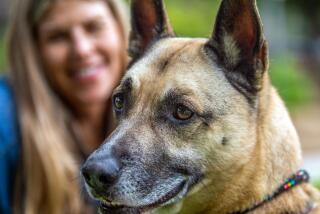Training Your Mate : How to Teach an Old Dog New Tricks for Valentine’s Day
- Share via
THIS year, give her a valentine she’ll never forget,” reads an ad for a diamond- and ruby-studded bracelet. I shake my head sadly. So far, my three-year campaign to convince my husband that Valentine’s Day is not just a merchandising ploy dreamed up by florists has been totally unrewarding.
My friend Sabina says that I can easily train my mate to give me a gift. “All mates have to be trained,” she insists. I wince as she reports that last year, her prize student /boyfriend, Anthony, drove to the ends of the Valley and picked a bouquet of wildflowers to show that his love for her was boundless. “You can train a man to do anything,” Sabina assures me.
Like a dog? “Essentially, yes,” says Thomas Lasswell, a professor of sociology at USC. Lasswell calls it “operative conditioning.” “You reward people for doing what you want them to do,” he explains, adding that there can be difficulties. “For example, efforts to train a man to make a bed are going to be marginally successful if he doesn’t value having the bed made.”
Don’t I know it. So far, I’ve had training difficulties not only with bed making but also with the preferred storage area for dirty dishes (the dishwasher versus under the sofa) and soiled laundry (the hamper versus the chair /floor /doorknob). And numerous female acquaintances say that they are considering installing beepers similar to the seat-belt reminder in a car as a last-ditch effort to train their mates to leave toilet seats in the down, or closed, position.
Still, these are just routine housekeeping--or should I say, housebreaking--problems. Sabina, ever the optimist, is actually attempting to train Anthony to communicate--specifically, to pop the question. Not the big question, the ordinary question.
“I wait for hours for Anthony to ask me how my day was,” Sabina explains. “We’ve completely discussed his entire day in elaborate detail. And I’ll sit there thinking, ‘It’s got to happen. He’s got to ask.’ But he doesn’t ask.
“So I say, ‘Honey, it is now 9 o’clock. You’ve been home for five hours. You still haven’t asked me how my day was.’ And then I throw in a little guilt like, ‘How can you simply forget that I had a day?’ ”
Sabina maintains that The Guilt Method works, although you can’t expect it to work the first time or even the first few dozen times. “There are going to be months and months of his never asking how my day was, and I will have to repeat the same lesson over and over,” she admits. “But eventually, he’ll get it.”
I wonder. Once, when I complained to Duke that he wasn’t giving me sufficient positive feedback, he marveled, “You mean, even if I think something really loud, you can’t hear it?” For a while, I adopted The Pop Beads Method. I gave him a large bag of those plastic, colored beads that snap together, along with instructions to give me a bead every time he found something positive to say. The resulting necklace reminded him and reassured me that communication was actually taking place. This worked out so well that he offered to buy the second batch of beads. “I’m so lucky,” he said. “Some women would prefer diamonds.”
So would I. And my friend Mary has a way for me to get them. “Whip, chair and pistol,” she advises. “I’ve never been willing to say, ‘Oh, sweetheart, whatever makes you comfortable.’ Sure, I start off adorable. But the first time he breaks my Wedgwood, I find myself screaming, ‘What do you think you’re doing? You’re not home, eating out of a carry-out carton over the kitchen sink!’ ”
A real animal trainer, Matthew Margolis, president of the National Institute of Dog Training and co-author of “When Good Dogs Do Bad Things,” has another philosophy. “You’ve got to show or tell the animal what you want in a way that’s firm but not harsh,” he says. “If you want to train a dog, you have to use love, praise and affection. That’s what it responds to. It’s the same with people.”
Margolis contends that any mate can be trained if the trainer looks at the problem from the trainee’s point of view. “You have to figure out what will make the dog feel really good and reward it.” For example? “If you want a dog to kiss you, you put butter on your face,” he explains. “So scent your face with whatever brings a gleam to your mate’s eye. He’ll respond.”
An image flashes before my eyes. I’m lying in bed next to my husband with Laker tickets clenched in my teeth. Duke grabs the tickets, gives me a quick kiss and races out of the house to drive to the Forum, like a mouse stealing cheese from a trap.
But affection really isn’t the problem. Which is fortunate because, contrary to what Dr. Ruth says, you cannot sexually train your mate. Either he’s got it right from the start, or you’re doomed.
Still, the dog-training tips may help me avoid disappointment on Feb. 14. Though Duke insists that he finally realizes that Valentine’s Day is one of the Big Three gift days in a wife’s year (along with her anniversary and her birthday), I am leaving nothing to chance. I marshal my pugs, Bess and Stella, into the living room with an ample supply of their favorite reward, onion bagels. “You’re going to learn how to fetch long-stemmed roses from the florist,” I say firmly.
More to Read
Sign up for The Wild
We’ll help you find the best places to hike, bike and run, as well as the perfect silent spots for meditation and yoga.
You may occasionally receive promotional content from the Los Angeles Times.






